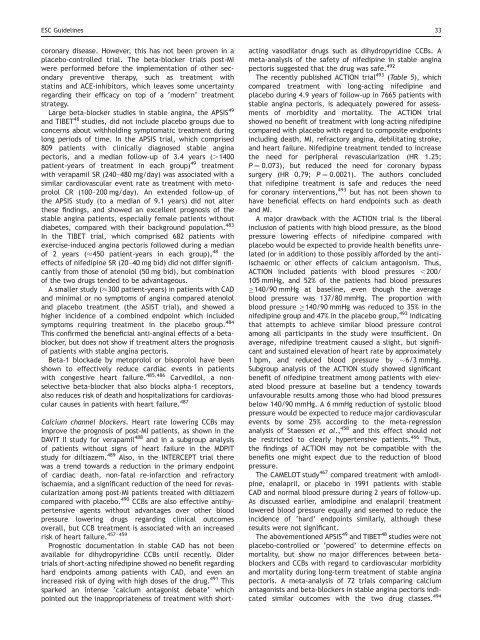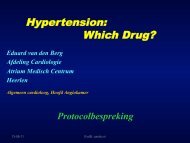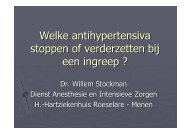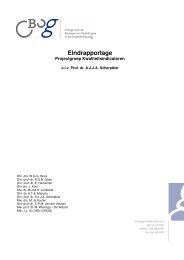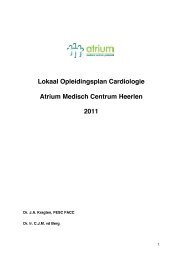Guidelines on the Management of Stable Angina Pectoris ... - Cardio
Guidelines on the Management of Stable Angina Pectoris ... - Cardio
Guidelines on the Management of Stable Angina Pectoris ... - Cardio
Create successful ePaper yourself
Turn your PDF publications into a flip-book with our unique Google optimized e-Paper software.
ESC <str<strong>on</strong>g>Guidelines</str<strong>on</strong>g> 33cor<strong>on</strong>ary disease. However, this has not been proven in aplacebo-c<strong>on</strong>trolled trial. The beta-blocker trials post-MIwere performed before <strong>the</strong> implementati<strong>on</strong> <strong>of</strong> o<strong>the</strong>r sec<strong>on</strong>darypreventive <strong>the</strong>rapy, such as treatment withstatins and ACE-inhibitors, which leaves some uncertaintyregarding <strong>the</strong>ir efficacy <strong>on</strong> top <strong>of</strong> a ‘modern’ treatmentstrategy.Large beta-blocker studies in stable angina, <strong>the</strong> APSIS 49and TIBET 48 studies, did not include placebo groups due toc<strong>on</strong>cerns about withholding symptomatic treatment duringl<strong>on</strong>g periods <strong>of</strong> time. In <strong>the</strong> APSIS trial, which comprised809 patients with clinically diagnosed stable anginapectoris, and a median follow-up <strong>of</strong> 3.4 years (.1400patient-years <strong>of</strong> treatment in each group) 49 treatmentwith verapamil SR (240–480 mg/day) was associated with asimilar cardiovascular event rate as treatment with metoprololCR (100–200 mg/day). An extended follow-up <strong>of</strong><strong>the</strong> APSIS study (to a median <strong>of</strong> 9.1 years) did not alter<strong>the</strong>se findings, and showed an excellent prognosis <strong>of</strong> <strong>the</strong>stable angina patients, especially female patients withoutdiabetes, compared with <strong>the</strong>ir background populati<strong>on</strong>. 483In <strong>the</strong> TIBET trial, which comprised 682 patients wi<strong>the</strong>xercise-induced angina pectoris followed during a median<strong>of</strong> 2 years (450 patient-years in each group), 48 <strong>the</strong>effects <strong>of</strong> nifedipine SR (20–40 mg bid) did not differ significantlyfrom those <strong>of</strong> atenolol (50 mg bid), but combinati<strong>on</strong><strong>of</strong> <strong>the</strong> two drugs tended to be advantageous.A smaller study (300 patient-years) in patients with CADand minimal or no symptoms <strong>of</strong> angina compared atenololand placebo treatment (<strong>the</strong> ASIST trial), and showed ahigher incidence <strong>of</strong> a combined endpoint which includedsymptoms requiring treatment in <strong>the</strong> placebo group. 484This c<strong>on</strong>firmed <strong>the</strong> beneficial anti-anginal effects <strong>of</strong> a betablocker,but does not show if treatment alters <strong>the</strong> prognosis<strong>of</strong> patients with stable angina pectoris.Beta-1 blockade by metoprolol or bisoprolol have beenshown to effectively reduce cardiac events in patientswith c<strong>on</strong>gestive heart failure. 485,486 Carvedilol, a n<strong>on</strong>selectivebeta-blocker that also blocks alpha-1 receptors,also reduces risk <strong>of</strong> death and hospitalizati<strong>on</strong>s for cardiovascularcauses in patients with heart failure. 487Calcium channel blockers. Heart rate lowering CCBs mayimprove <strong>the</strong> prognosis <strong>of</strong> post-MI patients, as shown in <strong>the</strong>DAVIT II study for verapamil 488 and in a subgroup analysis<strong>of</strong> patients without signs <strong>of</strong> heart failure in <strong>the</strong> MDPITstudy for diltiazem. 489 Also, in <strong>the</strong> INTERCEPT trial <strong>the</strong>rewas a trend towards a reducti<strong>on</strong> in <strong>the</strong> primary endpoint<strong>of</strong> cardiac death, n<strong>on</strong>-fatal re-infarcti<strong>on</strong> and refractoryischaemia, and a significant reducti<strong>on</strong> <strong>of</strong> <strong>the</strong> need for revascularizati<strong>on</strong>am<strong>on</strong>g post-MI patients treated with diltiazemcompared with placebo. 490 CCBs are also effective antihypertensiveagents without advantages over o<strong>the</strong>r bloodpressure lowering drugs regarding clinical outcomesoverall, but CCB treatment is associated with an increasedrisk <strong>of</strong> heart failure. 457–459Prognostic documentati<strong>on</strong> in stable CAD has not beenavailable for dihydropyridine CCBs until recently. Oldertrials <strong>of</strong> short-acting nifedipine showed no benefit regardinghard endpoints am<strong>on</strong>g patients with CAD, and even anincreased risk <strong>of</strong> dying with high doses <strong>of</strong> <strong>the</strong> drug. 491 Thissparked an intense ‘calcium antag<strong>on</strong>ist debate’ whichpointed out <strong>the</strong> inappropriateness <strong>of</strong> treatment with shortactingvasodilator drugs such as dihydropyridine CCBs. Ameta-analysis <strong>of</strong> <strong>the</strong> safety <strong>of</strong> nifedipine in stable anginapectoris suggested that <strong>the</strong> drug was safe. 492The recently published ACTION trial 493 (Table 5), whichcompared treatment with l<strong>on</strong>g-acting nifedipine andplacebo during 4.9 years <strong>of</strong> follow-up in 7665 patients withstable angina pectoris, is adequately powered for assessments<strong>of</strong> morbidity and mortality. The ACTION trialshowed no benefit <strong>of</strong> treatment with l<strong>on</strong>g-acting nifedipinecompared with placebo with regard to composite endpointsincluding death, MI, refractory angina, debilitating stroke,and heart failure. Nifedipine treatment tended to increase<strong>the</strong> need for peripheral revascularizati<strong>on</strong> (HR 1.25;P ¼ 0.073), but reduced <strong>the</strong> need for cor<strong>on</strong>ary bypasssurgery (HR 0.79; P ¼ 0.0021). The authors c<strong>on</strong>cludedthat nifedipine treatment is safe and reduces <strong>the</strong> needfor cor<strong>on</strong>ary interventi<strong>on</strong>s, 493 but has not been shown tohave beneficial effects <strong>on</strong> hard endpoints such as deathand MI.A major drawback with <strong>the</strong> ACTION trial is <strong>the</strong> liberalinclusi<strong>on</strong> <strong>of</strong> patients with high blood pressure, as <strong>the</strong> bloodpressure lowering effects <strong>of</strong> nifedipine compared withplacebo would be expected to provide health benefits unrelated(or in additi<strong>on</strong>) to those possibly afforded by <strong>the</strong> antiischaemicor o<strong>the</strong>r effects <strong>of</strong> calcium antag<strong>on</strong>ism. Thus,ACTION included patients with blood pressures ,200/105 mmHg, and 52% <strong>of</strong> <strong>the</strong> patients had blood pressures140/90 mmHg at baseline, even though <strong>the</strong> averageblood pressure was 137/80 mmHg. The proporti<strong>on</strong> withblood pressure 140/90 mmHg was reduced to 35% in <strong>the</strong>nifedipine group and 47% in <strong>the</strong> placebo group, 493 indicatingthat attempts to achieve similar blood pressure c<strong>on</strong>trolam<strong>on</strong>g all participants in <strong>the</strong> study were insufficient. Onaverage, nifedipine treatment caused a slight, but significantand sustained elevati<strong>on</strong> <strong>of</strong> heart rate by approximately1 bpm, and reduced blood pressure by 6/3 mmHg.Subgroup analysis <strong>of</strong> <strong>the</strong> ACTION study showed significantbenefit <strong>of</strong> nifedipine treatment am<strong>on</strong>g patients with elevatedblood pressure at baseline but a tendency towardsunfavourable results am<strong>on</strong>g those who had blood pressuresbelow 140/90 mmHg. A 6 mmHg reducti<strong>on</strong> <strong>of</strong> systolic bloodpressure would be expected to reduce major cardiovascularevents by some 25% according to <strong>the</strong> meta-regressi<strong>on</strong>analysis <strong>of</strong> Staessen et al., 458 and this effect should notbe restricted to clearly hypertensive patients. 466 Thus,<strong>the</strong> findings <strong>of</strong> ACTION may not be compatible with <strong>the</strong>benefits <strong>on</strong>e might expect due to <strong>the</strong> reducti<strong>on</strong> <strong>of</strong> bloodpressure.The CAMELOT study 467 compared treatment with amlodipine,enalapril, or placebo in 1991 patients with stableCAD and normal blood pressure during 2 years <strong>of</strong> follow-up.As discussed earlier, amlodipine and enalapril treatmentlowered blood pressure equally and seemed to reduce <strong>the</strong>incidence <strong>of</strong> ‘hard’ endpoints similarly, although <strong>the</strong>seresults were not significant.The abovementi<strong>on</strong>ed APSIS 49 and TIBET 48 studies were notplacebo-c<strong>on</strong>trolled or ‘powered’ to determine effects <strong>on</strong>mortality, but show no major differences between betablockersand CCBs with regard to cardiovascular morbidityand mortality during l<strong>on</strong>g-term treatment <strong>of</strong> stable anginapectoris. A meta-analysis <strong>of</strong> 72 trials comparing calciumantag<strong>on</strong>ists and beta-blockers in stable angina pectoris indicatedsimilar outcomes with <strong>the</strong> two drug classes. 494


